Algae
| Media | Family | Scientific name | Common name | Origin |
 | Gomphonemataceae | Didymosphenia geminata | Didymo | Cryptogenic |
Montana, USA, has a wide variety of invasive aquatic species ranging from algae to turtles. The effect each invasive species has on the environment varies greatly, some species are devastating while others are negligible. [1] Aquatic plants and algae may easily be transported from lake to lake by boaters who do not take the necessary precautions when launching their boats into new bodies of water. [2] Sometimes, pet owners release their pets into a non-native habitat where they will actually thrive and eventually establish a population and then begin to displace the native species that it competes with. [3]
| Media | Family | Scientific name | Common name | Origin |
 | Gomphonemataceae | Didymosphenia geminata | Didymo | Cryptogenic |
| Media | Family | Scientific name | Common name | Origin |
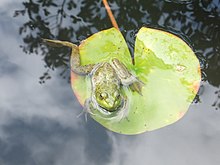 | Ranidae | Lithobates catesbeianus | American bullfrog | Native transplant |
 | Hylidae | Pseudacris regilla | Northern Pacific tree frog | Native transplant |
| Media | Family | Scientific Name | Common name | Origin |
 | Centrarchidae | Ambloplites rupestris | Rock bass | Native transplant |
 | Ictaluridae | Ameiurus melas | Black bullhead | Native transplant |
 | Ictaluridae | Ameiurus natalis | Yellow bullhead | Native transplant |
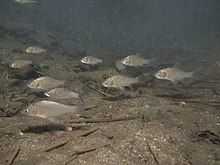 | Cyprinidae | Carassius auratus | Goldfish | Exotic |
 | Catostomidae | Catostomus ardens | Utah sucker | Native transplant |
 | Catostomidae | Catostomus commersonii | White sucker | Native transplant |
 | Salmonidae | Coregonus artedi | Cisco | Native transplant |
 | Salmonidae | Coregonus clupeaformis | Lake whitefish | Native transplant |
 | Cyprinidae | Couesius plumbeus | Lake chub | Native transplant |
 | Gasterosteidae | Culaea inconstans | Brook stickleback | Native transplant |
 | Cyprinidae | Cyprinus carpio | Common carp | Exotic |
| Esocidae | Esox lucius | Northern pike | Native transplant | |
 | Esocidae | Esox lucius × masquinongy | Tiger muskellunge | Native hybrid |
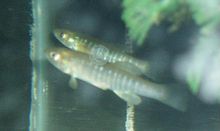 | Fundulidae | Fundulus kansae | Northern Plains killifish | Native transplant |
 | Fundulidae | Fundulus zebrinus | Plains killifish | Native transplant |
 | Poeciliidae | Gambusia affinis | Western mosquitofish | Native transplant |
 | Cyprinidae | Gila atraria | Utah chub | Native transplant |
 | Ictaluridae | Ictalurus punctatus | Channel catfish | Native transplant |
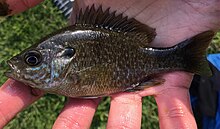 | Centrarchidae | Lepomis cyanellus | Green sunfish | Native transplant |
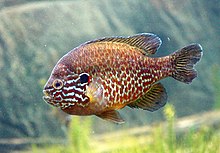 | Centrarchidae | Lepomis gibbosus | Pumpkinseed | Native transplant |
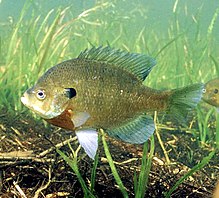 | Centrarchidae | Lepomis macrochirus | Bluegill | Native transplant |
 | Centrarchidae | Micropterus dolomieu | Smallmouth bass | Native transplant |
 | Centrarchidae | Micropterus salmoides | Largemouth bass | Native transplant |
 | Moronidae | Morone chrysops | White bass | Native transplant |
 | Cyprinidae | Notemigonus crysoleucas | Golden shiner | Native transplant |
 | Cyprinidae | Notropis hudsonius | Spottail shiner | Native transplant |
 | Salmonidae | Oncorhynchus aguabonita | Golden trout | Native transplant |
 | Salmonidae | Oncorhynchus clarkii bouvieri | Yellowstone cutthroat trout | Native transplant |
 | Salmonidae | Oncorhynchus clarkii lewisi | Westslope cutthroat trout | Native transplant |
 | Salmonidae | Oncorhynchus clarkii × mykiss | Cutbow trout | Native hybrid |
 | Salmonidae | Oncorhynchus kisutch | Coho salmon | Native transplant |
 | Salmonidae | Oncorhynchus mykiss | Rainbow trout | Native transplant |
 | Salmonidae | Oncorhynchus mykiss ssp. | Redband trout | Native transplant |
 | Salmonidae | Oncorhynchus nerka | Sockeye salmon | Native transplant |
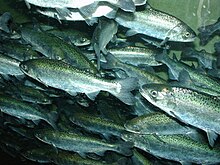 | Salmonidae | Oncorhynchus tshawytscha | Chinook salmon | Native transplant |
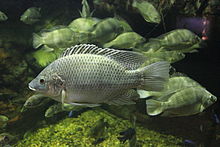 | Cichlidae | Oreochromis mossambicus | Mozambique tilapia | Exotic |
 | Osmeridae | Osmerus mordax | Rainbow smelt | Native transplant |
 | Percidae | Perca flavescens | Yellow perch | Native transplant |
 | Characidae | Piaractus brachypomus | Pirapitinga, red-bellied pacu | Exotic |
 | Cyprinidae | Pimephales promelas | Fathead minnow | Native transplant |
 | Poeciliidae | Poecilia latipinna | Sailfin molly | Native transplant |
 | Poeciliidae | Poecilia mexicana | Shortfin molly | Exotic |
| Poeciliidae | Poecilia reticulata | Guppy | Exotic | |
 | Poeciliidae | Poecilia sphenops | Mexican molly | Exotic |
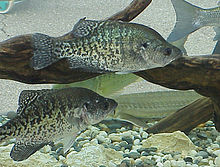 | Centrarchidae | Pomoxis annularis | White crappie | Native transplant |
 | Centrarchidae | Pomoxis nigromaculatus | Black crappie | Native transplant |
 | Cyprinidae | Richardsonius balteatus | Redside shiner | Exotic |
 | Salmonidae | Salmo letnica | Ohrid trout | Exotic |
 | Salmonidae | Salmo salar sebago | Atlantic salmon | Native transplant |
 | Salmonidae | Salmo trutta | Brown trout | Exotic |
 | Salmonidae | Salmo trutta × Salvelinus fontinalis | Tiger trout | Exotic hybrid |
 | Salmonidae | Salvelinus fontinalis | Brook trout | Native transplant |
 | Salmonidae | Salvelinus namaycush | Lake trout | Native transplant |
 | Percidae | Sander canadensis × vitreus | Saugeye | Native hybrid |
 | Percidae | Sander vitreus | Walleye | Native transplant |
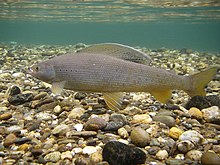 | Salmonidae | Thymallus arcticus | Arctic grayling | Native transplant |
 | Umbridae | Umbra limi | Central mudminnow | Native transplant |
 | Poeciliidae | Xiphophorus hellerii | Green swordtail | Exotic |
 | Poeciliidae | Xiphophorus maculatus | Southern platyfish | Exotic |
 | Poeciliidae | Xiphophorus variatus | Variable platyfish | Exotic |
| Media | Family | Scientific name | Common name | Origin |
 | Myocastoridae | Myocastor coypus | Nutria | Exotic |
| Media | Family | Scientific name | Common name | Origin |
 | Cyrenidae | Corbicula fluminea | Asian clam | Exotic |
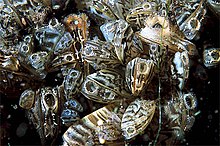 | Dreissenidae | Dreissena sp. | Zebra muscle | Exotic |
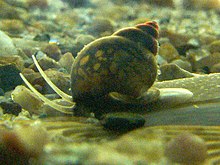 | Bithyniidae | Bithynia tentaculata | Mud bithynia, faucet snail | Exotic |
 | Thiaridae | Melanoides tuberculata | Red-rim melania | Exotic |
 | Physidae | Physella acuta | Acute bladder snail | Native transplant |
 | Hydrobiidae | Potamopyrgus antipodarum | New Zealand mudsnail | Exotic |
 | Lymnaeidae | Radix auricularia | European ear snail | Exotic |
| Media | Family | Scientific name | Common name | Origin |
 | Poaceae | Alopecurus geniculatus | Water foxtail | Exotic |
 | Butomaceae | Butomus umbellatus | Flowering rush | Exotic |
 | Plantaginaceae | Callitriche stagnalis | Pond water-starwort | Exotic |
 | Iridaceae | Iris pseudacorus | Yellow iris | Exotic |
 | Juncaceae | Juncus compressus | Roundfruit rush | Exotic |
 | Juncaceae | Juncus gerardii | Saltmeadow rush | Native transplant |
 | Lythraceae | Lythrum salicaria | Purple loosestrife | Exotic |
 | Boraginaceae | Myosotis scorpioides | Forget-me-not | Exotic |
 | Haloragaceae | Myriophyllum aquaticum | Parrot feather | Exotic |
 | Haloragaceae | Myriophyllum spicatum | Eurasian watermilfoil | Exotic |
 | Hydrocharitaceae | Najas marina | Holly-leaf waternymph | Native transplant |
 | Brassicaceae | Nasturtium officinale | water-cress | Exotic |
 | Nymphaeaceae | Nymphaea odorata | American white waterlily | Native transplant |
 | Poaceae | Phalaris arundinacea | Reed canarygrass | Exotic |
 | Potamogetonaceae | Potamogeton crispus | Curly-leaf pondweed | Exotic |
 | Brassicaceae | Rorippa sylvestris | Keek | Exotic |
 | Tamaricaceae | Tamarix | Tamarisk | Exotic |
 | Typhaceae | Typha angustifolia | Narrow-leaved cattail | Exotic |
 | Hydrocharitaceae | Vallisneria americana | Wild-celery | Native transplant |
| Media | Family | Scientific name | Common name | Origin |
 | Chelydridae | Chelydra serpentina | Snapping turtle | Native transplant |
| Media | Family | Scientific name | Common name | Origin |
 | Gammaridae | Gammarus sp. | Amphipod | Native transplant |
 | Cambaridae | Faxonius virilis | Virile crayfish, northern crayfish | Native transplant |
 | Mysidae | Mysis diluviana | Opossum shrimp | Native transplant |

An algal bloom or algae bloom is a rapid increase or accumulation in the population of algae in freshwater or marine water systems. It is often recognized by the discoloration in the water from the algae's pigments. The term algae encompasses many types of aquatic photosynthetic organisms, both macroscopic multicellular organisms like seaweed and microscopic unicellular organisms like cyanobacteria. Algal bloom commonly refers to the rapid growth of microscopic unicellular algae, not macroscopic algae. An example of a macroscopic algal bloom is a kelp forest.
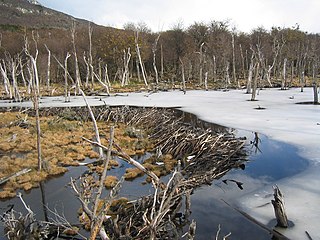
An invasive species is an introduced species to an environment that becomes overpopulated and harms its new environment. Invasive species adversely affect habitats and bioregions, causing ecological, environmental, and/or economic damage. The term can also be used for native species that become harmful to their native environment after human alterations to its food web. Since the 20th century, invasive species have become a serious economic, social, and environmental threat worldwide.

The Nile perch, also known as the African snook, Goliath perch, African barramundi, Goliath barramundi, Giant lates or the Victoria perch, is a species of freshwater fish in family Latidae of order Perciformes. It is widespread throughout much of the Afrotropical realm, being native to the Congo, Nile, Senegal, Niger and Lake Chad, Volta, Lake Turkana, and other river basins. It also occurs in the brackish waters of Lake Maryut in Egypt. The Nile perch is a fish of substantial economic and food-security importance in East Africa. Originally described as Labrus niloticus, among the marine wrasses, the species has also been referred to as Centropomus niloticus. Common names include African snook, Victoria perch, and many local names in various African languages, such as the Luo name mbuta or mputa. In Tanzania, it is called sangara, sankara, or chenku. In Francophone African countries, it is known as capitaine. Its name in the Hausa language is giwan ruwa, meaning "water elephant".

Aquatic plants are plants that have adapted to living in aquatic environments. They are also referred to as hydrophytes or macrophytes to distinguish them from algae and other microphytes. A macrophyte is a plant that grows in or near water and is either emergent, submergent, or floating. In lakes and rivers macrophytes provide cover for fish, substrate for aquatic invertebrates, produce oxygen, and act as food for some fish and wildlife.
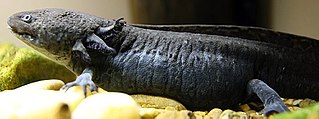
The axolotl is a paedomorphic salamander closely related to the tiger salamander. It is unusual among amphibians in that it reaches adulthood without undergoing metamorphosis. Instead of taking to the land, adults remain aquatic and gilled. The species was originally found in several lakes underlying what is now Mexico City, such as Lake Xochimilco and Lake Chalco. These lakes were drained by Spanish settlers after the conquest of the Aztec Empire, leading to the destruction of much of the axolotl's natural habitat.
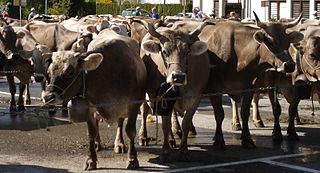
An introduced species, alien species, exotic species, adventive species, immigrant species, foreign species, non-indigenous species, or non-native species is a species living outside its native distributional range, but which has arrived there by human activity, directly or indirectly, and either deliberately or accidentally. Non-native species can have various effects on the local ecosystem. Introduced species that become established and spread beyond the place of introduction are considered naturalized. The process of human-caused introduction is distinguished from biological colonization, in which species spread to new areas through "natural" (non-human) means such as storms and rafting. The Latin expression neobiota captures the characteristic that these species are new biota to their environment in terms of established biological network relationships. Neobiota can further be divided into neozoa and neophyta (plants).

The zebra mussel is a small freshwater mussel. The species originates from the lakes of southern Russia and Ukraine, but has been accidentally introduced to numerous other areas and has become an invasive species in many countries worldwide. Since the 1980s, the species has invaded the Great Lakes, Hudson River, and Lake Travis. The adverse effects of dreissenid mussels on freshwater systems have led to their ranking as one of the world's most invasive aquatic species.
Freshwater ecosystems are a subset of Earth's aquatic ecosystems. They include lakes, ponds, rivers, streams, springs, bogs, and wetlands. They can be contrasted with marine ecosystems, which have a larger salt content. Freshwater habitats can be classified by different factors, including temperature, light penetration, nutrients, and vegetation. There are three basic types of freshwater ecosystems: Lentic, lotic and wetlands. Freshwater ecosystems contain 41% of the world's known fish species.
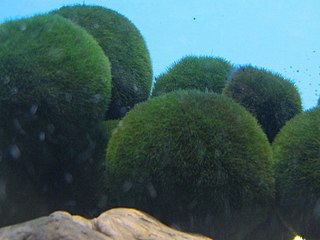
Marimo is a rare growth form of Aegagropila linnaei in which the algae grow into large green balls with a velvety appearance.
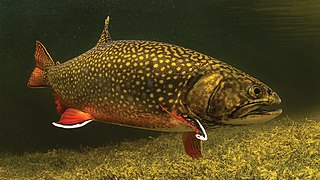
The brook trout is a species of freshwater fish in the char genus Salvelinus of the salmon family Salmonidae native to Eastern North America in the United States and Canada. Two ecological forms of brook trout have been recognized by the US Forest Service. One ecological form is short-lived potamodromous populations in Lake Superior known as coaster trout or coasters. The second ecological form is the long-living predaceous anadromous populations which are found in northern lakes and coastal rivers from Long Island to Hudson Bay, which are referred to as salters. In parts of its range, it is also known as the eastern brook trout, speckled trout, brook charr, squaretail, brookie, or mud trout, among others. Adult coaster brook trout are capable of reaching sizes over 2 feet in length and weigh up to 6.8 kg, whereas adult salters average between 6 to 15 inches in length and weigh between 0.5 and 2.3 kg. The brook trout is characterized by its distinctive olive-green body with yellow and blue-rimmed red spots, white and black edged orange fins, and dorsal vermiculation. The diet of the brook trout is restrictive to the season and location of the fish, but will typically consist of terrestrial and aquatic insects, fry, crustaceans, zooplankton, and worms.

The quagga mussel is a species of freshwater mussel, an aquatic bivalve mollusk in the family Dreissenidae. It has an average lifespan of 3 to 5 years.

An aquatic ecosystem is an ecosystem found in and around a body of water, in contrast to land-based terrestrial ecosystems. Aquatic ecosystems contain communities of organisms—aquatic life—that are dependent on each other and on their environment. The two main types of aquatic ecosystems are marine ecosystems and freshwater ecosystems. Freshwater ecosystems may be lentic ; lotic ; and wetlands.
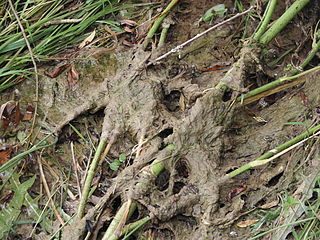
Didymosphenia geminata, commonly known as didymo or rock snot, is a species of diatom that produces nuisance growths in freshwater rivers and streams with consistently cold water temperatures and low nutrient levels. It is native to the northern hemisphere, and considered an invasive species in Australia, Argentina, New Zealand, and Chile. Even within its native range, it has taken on invasive characteristics since the 1980s. It is not considered a significant human health risk, but it can affect stream habitats and sources of food for fish and make recreational activities unpleasant. This microscopic alga can be spread in a single drop of water.

The New Zealand mud snail is a species of very small freshwater snail with a gill and an operculum. This aquatic gastropod mollusk is in the family Tateidae.

The bigmouth buffalo is a fish native to North America that is in decline. It is the largest North American species in the Catostomidae or "sucker" family, and is one of the longest-lived and latest-maturing freshwater fishes, capable of living 127 years and reproducing infrequently. Even at a century old they show no age-related declines, but instead improvements relative to younger individuals, making this species a biological marvel. It is commonly called the gourdhead, marblehead, redmouth buffalo, buffalofish, bernard buffalo, roundhead, or brown buffalo. The bigmouth buffalo is not a carp, nor is any other fish in the sucker family. Although they share the same order, each belong to different suborders and are native to separate continents.

Freshwater fish are those that spend some or all of their lives in fresh water, such as rivers and lakes, with a salinity of less than 1.05%. These environments differ from marine conditions in many ways, especially the difference in levels of salinity. To survive fresh water, the fish need a range of physiological adaptations.

Corbicula fluminea is a species of freshwater clam native to eastern Asia which has become a successful invasive species throughout the world, including North America, South America, Europe, and New Zealand. It is native to freshwater environments of Eastern Asia, including Russia, Thailand, the Philippines, China, Taiwan, Korea, and Japan. C. fluminea also occurs naturally in freshwater environments of Africa. Corbicula fluminea is commonly known in the west as the Asian clam, Asiatic clam, or Asian gold clam. In Southeast Asia, C. fluminea is known as the golden clam, prosperity clam, pygmy clam, or good luck clam. In New Zealand, it is commonly referred as the freshwater gold clam.

A pond is a small, still, land-based body of water formed by pooling inside a depression, either naturally or artificially. A pond is smaller than a lake and there are no official criteria distinguishing the two, although defining a pond to be less than 5 hectares in area, less than 5 metres (16 ft) in depth and with less than 30% with emergent vegetation helps in distinguishing the ecology of ponds from those of lakes and wetlands. Ponds can be created by a wide variety of natural processes, or they can simply be isolated depressions filled by runoff, groundwater, or precipitation, or all three of these. They can be further divided into four zones: vegetation zone, open water, bottom mud and surface film. The size and depth of ponds often varies greatly with the time of year; many ponds are produced by spring flooding from rivers. Ponds are usually freshwater but may be brackish in nature. Saltwater pools, with a direct connection to the sea to maintain full salinity, may sometimes be called 'ponds' but these are normally regarded as part of the marine environment. They do not support fresh or brackish water-based organisms, and are rather tidal pools or lagoons.

Invasive species are a crucial threat to many native habitats and species of the United States and a significant cost to agriculture, forestry, and recreation. The term "invasive species" can refer to introduced/naturalized species, feral species, or introduced diseases. Some introduced species, such as the dandelion, do not cause significant economic or ecologic damage and are not widely considered as invasive. Economic damages associated with invasive species' effects and control costs are estimated at $120 billion per year.

Canadian aquatic invasive species are all forms of life that traditionally has not been native to Canada's waterways. In Eastern Canada, non-native plant and animal species are a concern to biologists. Bringing non-native species such as invasive fishes into Canada can damage the environment and ecosystem by repressing native species due to food competition or preying. Invasive fishes enter the fresh waters of Canada in several ways including drifting, deliberate introduction, accidental release, experimental purposes and, most commonly, through the attachment on international boat hulls. Invasive species are the second biggest threat to fish and other marine life in Canada behind loss of habitat and degradation. The threat to native species is primarily caused by impacts on the food web; however, invasive species also bring dangerous pathogens and physically interfere with existing aquatic life. Invasive species include sea lampreys, zebra mussels, smallmouth bass, European green crab, vase tunicate, and sea squirts.